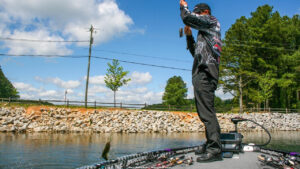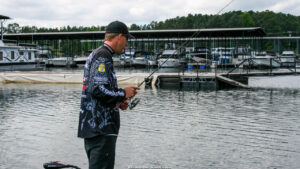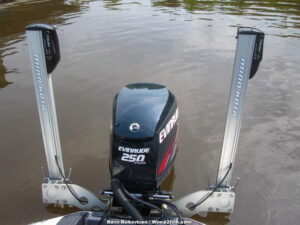When lake temperatures begin to dip, it signals the beginning some of the best smallmouth fishing of the season on big waters like the Great Lakes. While most anglers will concentrate on brown fish, those in the know also chase largemouth in marinas. These fish stack like cord wood into these often overlooked fishing areas.
Why marinas and harbors
- Weather—The often incredible open water fishing does come at a price on big waters like the Great Lakes. The caveat being that there are many days when no man or even freighter dare venture out into the lake. Whether you have traveled half way across the state to fun fish or a local that only has one day to get out, there is another often overlooked option. Marinas and harbors that connect these waterways make for great fishing alternatives when the wind and waves roar.
- Equipment—People sometimes need to be reminded where the Edmond Fitzgerald currently sits and how it got there. Big lakes tend to break things. It’s at this time of year that you don’t necessarily need a big boat to have good fishing. Marinas also can be an excellent option for those anglers without boats large enough to travel the open waters comfortably even during ideal weather conditions.
- Practice—In many northern bodies of water, it can be difficult to practice or learn a technique the conditions rarely fit. If you are heading down south in a few months this can be the perfect opportunity to brush up your skills with a seldom used technique. A good time for a light line finesse fisherman to put a flipping stick in his hands or vice versa.

Lures
Living on the shores of Lake Erie, I could probably throw nothing but a tube most of the year and catch fish consistently. Throw in a drop shot and maybe a crank, and that’s all you really need. Marina fishing is by no means complicated and could easily be classified as junk fishing. Ten different rods on the front deck, and you could likely catch bass on all 10. Depending on the type of cover and marina you are fishing however, 3 presentations cover nearly all circumstances you will encounter.
Jig—The classic jig and pig really needs no introduction, but it does need to be used. Rig with 15- to 20-pound fluorocarbon to get a good balance of sensitivity and strength. Some anglers will substitute a braid in scenarios where extremely dense cover exists. Keep it simple with color, but don’t overlook an all-white jig and trailer to mimic the shad dying in the colder water.
Shaky head—A small jighead with a light wire hook and finesse plastic can excel when fishing deep breaks or retaining walls with a rock or concrete block base. Fishing them on a spinning rod with 8-pound test will generally draw a few more bites, but increasing to 10-pound can save a few break-offs and jigheads when fishing around floating docks or where broken concrete and other man made materials exist. These smaller plastics are the ticket when exceptionally clear water is present, particularly around the edges of deep water docks. Throwing shallow and working it back deeper can trigger more strikes on some days than just working specific spots.
Spinnerbait—Not many things will allow you to cover water and imitate shad better than a spinnerbait. Make sure to try different blade types. Colorado blades excel in dirtier and shallower back waters, while less frequently used Indiana blades excel when working breaks or cleaner water. Don’t be afraid to cast nearly on shore and work very skinny water. Bass can be literally inches from shore with their backs almost out of the water. Throwing parallel to the bank and working progressively deeper to see how they are setup and how far they are willing to chase.

Locations
Some marinas and harbor systems are large enough to be considered a lake by themselves. If your plan is to start at the first set of docks by the ramp and work your way to the other end, you could be in for a long day. You likely will encounter 5 different types of structure/cover combinations to which fish relate. Try to fish several of them in the early part of the day to dial in a pattern. This fish-it-all pattern allows you to eliminate a lot of water once you figure out exactly where they are holding that day.
Natural shoreline—The main bank often is the most consistent pattern on these large waterways. The pattern from day to day can simply revolve around if they are in depressions, deep breaks or shallow banks from where the marina was dug out for expansion or dredging.
Docks—Floating docks can be key in clean water and during sunny conditions as bass use them for shade and the chance to chomp on bluegills. Fishing at the base of permanent docks poles is a staple and easy to check. For some reason fish tend to regularly set up on only one side of the docks, regardless of where in the marina you are. When starting out don’t just hit one or two poles on the end, check both sides.
Harbor mouths—Break walls look great but are often very inconsistent. High percentage areas are on the lake side of the break wall and should be checked if they are sheltered enough to safely fish.
Transitions—Perhaps one of the most consistent patterns is to fish where the manmade rocks or concrete meet mud. These small areas often fish small due to a major change in water clarity, rocks clean much quicker than the loose mud bottoms.
Retaining walls—Large steel sheets are commonly used to keep the bank from falling in and create a distinct 90 degree base. Fish often position at the base of the support poles. Cast right at the wall and fish as close as possible to it.

Get the most out of every area Aside from knowing what to throw and where to throw it, place an emphasis on casting accuracy. Marina fish hold as tight to cover as any other fishing scenario you will uncover. Getting your lure into an area that others don’t can be the difference between getting a better grade of fish or sometimes just getting a bite.
Keep in mind that you are also fishing around other people’s boats and property, so cast cautiously and precisely. Taking extra care to not “blow out” your fishing area or another potential fishing spot with your trolling motor can help increase the water you can fish. More often than not using a shallow water anchor like the Minn-Kota Talon allows you to fish specific areas without touching the trolling motor. Models are available to 12-foot, which allows you to hold in just about any place in the marina or harbor.
After a few times of fishing these large lake marina’s, you may not just fish them because the weather forces you there, but because you enjoy fishing there.
Follow author Ross Robertson on Facebook, Instagram, YouTube and his website BigWaterFishing.com.












